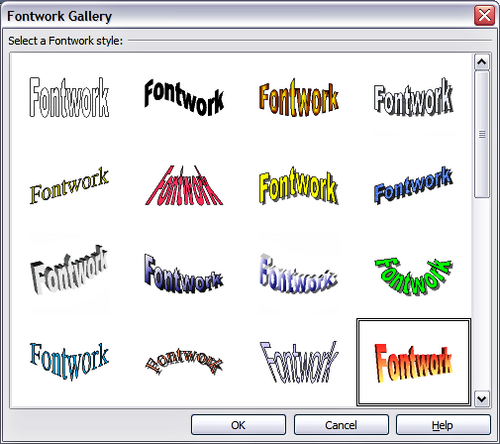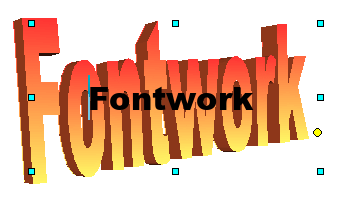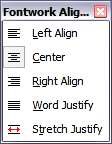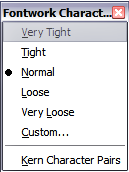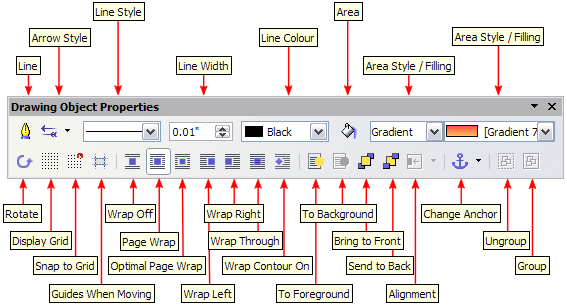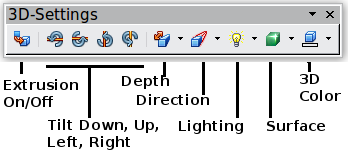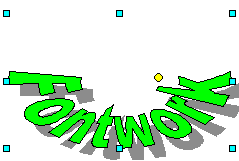Using Fontwork
Using Fontwork
With Fontwork you can create graphical text art objects to make your work more attractive. There are many settings for text art objects (line, area, position, size, and more), so you have many choices. You will surely find one that fits your document.
Fontwork is available with each component of AOO, but you will notice small differences in the way that each component displays it.
The Fontwork Toolbars
You can use two different toolbars for creating and editing a Fontwork object.
- Go to View → Toolbars → Fontwork.
- If you click on an existing Fontwork object, the Formatting toolbar changes to display the Fontwork options as shown in Figure 251. The contents of this toolbar vary depending on the AOO component with which it is being used.
Creating a Fontwork Object
- On the Drawing or Fontwork toolbar, click the Fontwork Gallery icon
 . If the Drawing toolbar is not visible, go to View → Toolbars → Drawing to display it.
. If the Drawing toolbar is not visible, go to View → Toolbars → Drawing to display it.
- In the Fontwork Gallery, select a Fontwork style, then click OK . The Fontwork object will appear in your document. Notice the colored squares around the edge (indicating that the object is selected) and the yellow dot; these are discussed in “Moving and Resizing Fontwork Objects”.
- Double-click the object to edit the Fontwork text. Type your own text in place of the black Fontwork text that appears over the object.
- Click anywhere in a free space or press Esc to apply your changes.
Editing a Fontwork Object
Now that the Fontwork object is created, you can edit some of its attributes. To do this, you can use the Fontwork toolbar, the Properties deck of the Sidebar, the Formatting toolbar, or menu options as described in this section. If the selected Fontwork object is a 3D object, you can also use the 3D-Settings toolbar.
Using the Fontwork Toolbar
Make sure that the Fontwork toolbar, shown in Figure 246, is visible. If you do not see it, go to View → Toolbars → Fontwork. Click on the different icons to edit Fontwork objects.
| |
Fontwork Shape: Edits the shape of the selected object. You can choose from a palette of shapes. |
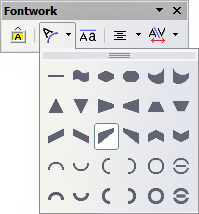
|
Using the Formatting Toolbar
Now let us go further and customize the Fontwork object with several more attributes.
Click on the Fontwork object. The Formatting toolbar changes to show the options for editing the object. (The toolbar shown in Figure 251 appears when you use Fontwork in Writer.)
This figure shows the toolbar floating. In its default, docked position it is one of the toolbars located below the menu bar. The example toolbar has also been customized to show all the available options; by default only a subset of these options is shown. Many of the icons that are available by default on the Formatting toolbar are also available on the Properties deck of the Sidebar.
On the Formatting toolbar you have a large choice of options for customizing your object. These choices are the same as the ones for other drawing objects. For more information, see the Draw Guide.
Line options
Line icon: Opens a dialog with three tabs: Line, Line Styles, Arrow Styles. Use the Line tab to edit the most common properties of the line around the selected Fontwork object, by choosing from previously-defined attributes including line style, line color, and arrow styles. Use the Lines Styles and Arrow Styles tabs to edit the properties of line and arrow styles, and define new styles. On the Sidebar, this dialog is accessed with the small icon at the right end of the panel Line title bar.
Arrow Style icon: Choose from the different arrow styles.
Line Style box: Choose from the available line styles.
Line Width box: Set the width of the line.
Line Color box: Select the color of the line.
Area options
Area icon: Opens a dialog with seven tabs: Area, Shadow, Transparency, Colors, Gradients, Hatching, Bitmaps. On the Sidebar, this dialog is accessed with the small icon at the right end of the panel Area title bar.
- Area tab: Choose from the predefined list a color, bitmap, gradient or hatching pattern to fill the selected object.
- Shadow tab: Set the shadow properties of the selected object.
- Transparency tab: Set the transparency properties of the selected object.
- Colors tab: Modify the available colors or add new ones to appear on the Area tab.
- Gradients tab: Modify the available gradients or add new ones to appear on the Area tab.
- Hatching tab: Modify the available hatching patterns or add new ones to appear on the Area tab.
- Bitmaps tab: Create simple bitmap patterns and import bitmaps, to make them available on the Area tab.
Area Style / Filling boxes: Select the type of the fill of the selected object. For more detailed settings, use the Area icon.
Positioning options
Rotate icon: Rotate the selected object manually using the mouse to drag the object.
To Foreground icon: Move the selected object in front of the text.
To Background icon: Move the selected object behind the text.
Alignment icon: Modify the alignment of the selected objects.
Bring to front icon: Move the selected object in front of the others.
Send to back icon: Move the selected object behind the others.
Change Anchor icon: Choose between anchoring options:
- To Page—The object keeps the same position in relation to the page margins. It does not move as you add or delete text.
- To Paragraph—The object is associated with a paragraph and moves with the paragraph. It may be placed in the margin or another location.
- To Character—The object is associated with a character but is not in the text sequence. It moves with the paragraph but may be placed in the margin or another location. This method is similar to anchoring to a paragraph.
- As Character—The object is placed in the document like any character and moves with the paragraph as you add or delete text before the object.
Ungroup icon: Ungroup the selected objects, so you can manage them individually.
Group icon: Group the selected objects, so you can manage them as a single object.
Using Menu Options
You can use some choices on the Format menu to anchor, align, arrange and group selected Fontwork objects, wrap text around them, and flip them horizontally and vertically.
You can also right-click on a Fontwork object and choose many of the same options from the pop-up menu. The pop-up menu also provides quick access to the Line, Area, Text, and Position and Size dialogs. The Text dialog offers only a few options for Fontwork objects and is not discussed here. On the Position and Size dialog, you can enter precise values concerning size and position. For more information on all of these menu options, see the Draw Guide.
Using the 3D-Settings Toolbar
If the selected Fontwork object is a 3D object, you can also use the options on the 3D-Settings toolbar. You can also change a 2D Fontwork object into a 3D object (or change a 3D object into a 2D object) by clicking the Extrusion On/Off icon on the 3D-Settings toolbar. For more information, see the Draw Guide.
Moving and Resizing Fontwork Objects
When you select a Fontwork object, eight colored squares (known as handles) appear around the edge of the object, as shown below. You can drag these handles to resize the object.
For precise control of the location and size of the object, use the Position and Size dialog.
| Content on this page is licensed under the Creative Common Attribution 3.0 license (CC-BY). |

